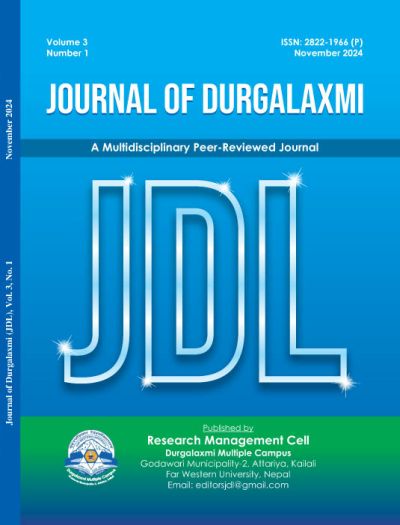Exploring Health Resilience Practices in Lumbini, Karnali, and Sudurpaschim Provinces
DOI:
https://doi.org/10.3126/jdl.v3i1.73870Keywords:
migration, culture of safty, health resilience, Lumbini, Karnali, SudurpaschimAbstract
Individual and communal identities, impacting businesses, professions, cultures, traditions, as well as political and economic factors, have a two-way relationship with the structure of societies. Society also determines the health and well-being of its members. A large proportion of this region's population has migrated to India to earn basic livelihoods, which has led to inherited health consequences. This study examines multiple data sources from the three provinces with the highest poverty rates in Nepal - Sudurpaschim, Karnali, and Lumbini—utilizing a variety of data sources. We searched for literature on Google using the search terms Lumbini, Karnali, Sudurpaschim, health policies, strategic priorities, and Province Government Plans. We also searched online media reports. To enrich the research with real-world perspectives, the study incorporated insights from the members of development project staff working directly within these provinces. The following eight conditions are among the top ten across all three provinces and account for almost 50% of all outpatient (OPD) visits: Lower Respiratory Tract Infection; Musculoskeletal Pain; Falls/Injuries/Fractures; Gastritis; Headache; Presumed Non-Infectious Diarrhoea; Other Surgical Problems; and Upper Respiratory Tract Infection. With rising life expectancy, the issue of older people's health is emerging as a challenge for Nepal's healthcare system. The situation is exacerbated by these provinces' vulnerability to natural disasters, climate change effects, and issues related to human-animal conflict and property damage. In the context where these provinces face a shortage of health workforce, the use of a digital approach could be helpful. Utilizing digital technology has positive impacts on human health outcomes by improving digital health literacy, we concluded that mobilizing community groups to identify problems, collaboratively prioritizing them to develop solutions, and co-creating a digital literacy system can amplify outreach to improve health outcomes for people in Nepal's three poorest provinces.
Downloads
Downloads
Published
How to Cite
Issue
Section
License

This work is licensed under a Creative Commons Attribution-NonCommercial 4.0 International License.
CC BY-NC: This license allows reusers to distribute, remix, adapt, and build upon the material in any medium or format for noncommercial purposes only, and only so long as attribution is given to the creator.




